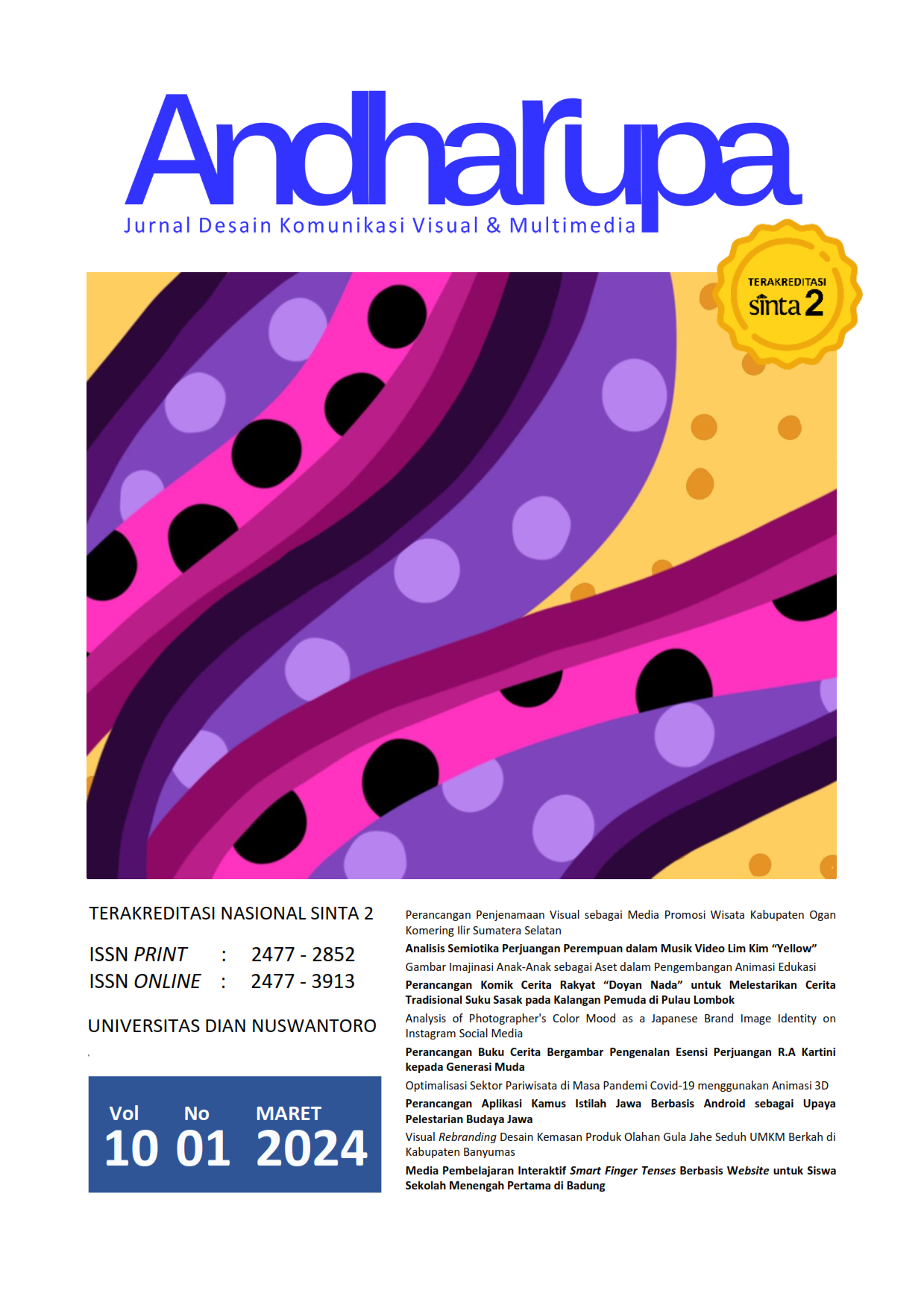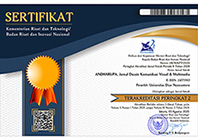PENERAPAN VIRTUAL REALITY COSMIC SPACE UNTUK MELATIH KEMAMPUAN RELAKSASI DAN FOKUS PADA PENGGUNA GANGGUAN ANXIETY DISORDER
DOI:
https://doi.org/10.33633/andharupa.v10i01.7146Abstract
AbstrakAnxiety Disorder adalah kecemasan yang ditandai dengan serangan panik berulang, yaitu serangan ketakutan yang terus menerus dan terjadi reaksi fisik yang parah secara tiba-tiba tanpa bahaya yang nyata atau alasan yang jelas. Gangguan kecemasan sering didiagnosis pada generasi muda hingga dewasa. Virtual reality (VR) adalah teknologi baru yang menjanjikan dan menawarkan peluang untuk memodulasi pengalaman dan kognisi pengguna untuk meminimalisir tingkat kecemasan. Penelitian ini menggunakan metode mixed methods. Metode kualitatif digunakan dalam proses perancangan serta penjelasan deskriptif terkait memahami fenomena tentang apa yang dialami oleh subjek penelitian sebelum dan sesudah uji eksperimen. Metode kuantitatif digunakan untuk mengukur kelayakan aplikasi melalui Uji UAT (User Acceptance Testing). Penelitian ini bertujuan untuk membuat aplikasi game VR dengan visual pola gelombang cosmic yang dapat meningkatkan relaksasi dan melatih konsentrasi pengguna dengan memanfaatkan VR Gear. Hasil pengujian, peringkat pengguna, dan penilaian pakar media nantinya akan digunakan untuk mengukur efektivitas dari luaran penelitian ini. Hasil akhir pada penelitian ini akan digunakan sebagai media terapi pendukung untuk membantu meningkatkan relaksasi user dengan gangguan anxiety guna meningkatkan konsentrasi pengguna saat memasuki dunia immersive. Kata Kunci: anxiety disorder, Cosmic Space, game, media terapi, virtual reality AbstractAnxiety Disorder is anxiety characterized by recurrent panic attacks, namely continuous attacks of fear and sudden, severe physical reactions without any real danger or clear reason. Anxiety disorders are often diagnosed in the younger generation and adults. Virtual reality (VR) is a promising new technology that offers opportunities to modulate user experience and cognition to minimize anxiety levels. This research uses mixed methods. Qualitative methods are used in the design as well as descriptive explanations related to understanding the phenomena experienced by research subjects before and after experimental tests. Quantitative methods are used to measure application feasibility through UAT Testing (User Acceptance Testing). This research aims to create a VR game application with visual cosmic wave patterns that can increase relaxation and train user concentration by utilizing VR Gear. Test results, user ratings and media expert assessments will later be used to measure the effectiveness of this research output. The final results of this research will be used as a supporting therapy medium to help increase relaxation for users with anxiety disorders in order to increase user concentration when entering the immersive world Keywords: anxiety disorder, Cosmic Space, game, therapy media, virtual realityReferences
Arikunto, Suharsimi. (2013). Prosedur Penelitian Suatu Pendekatan Praktik. Jakarta: Rineka Cipta.
Chesham, R. K., Malouff, J. M., & Schutte, N. S. (2018). Meta-Analysis of the Efficacy of Virtual reality Exposure Therapy for Social Anxiety. Behaviour Change, 35(3), 152–166
Davison, G.C., Neale J.M., &Kring A.M. (2004). Psikologi Abnormal Edisi ke-9. Jakarta: PT Raja Grafindo Persada.
Emmelkamp, P. M. G. (2005). Technological Innovations in Clinical Assessment and Psychotherapy. Psychotherapy and Psychosomatics, 74(6), 336–343.
Hugh-Jones, S, Ulor, M, Nugent, T., Walshe, S., Kirk, M. (2023). The Potential of Virtual reality To Support Adolescent Mental Well-Being in Schools: A UK Co-Design And Proof-Of-Concept Study. Mental Health & Prevention Vol 30, ISSN 2212-6570,
Kim H, Kim DJ, Kim S, Chung WH, Park K-A, Kim JDK, Kim D, Kim MJ, Kim K and Jeon HJ. (2021). Effect of Virtual reality on Stress Reduction and Change of Physiological Parameters Including Heart Rate Variability in People with High Stress: An Open Randomized Crossover Trial. Front. Psychiatry 12:614539.
Krijn, M., Emmelkamp, P. M. G., Ólafsson, R. P., & Biemond, R. (2004). Virtual reality exposure therapy of anxiety disorders: A review. Clinical Psychology Review, 24(3), 259–281.
Mathers, C. D., & Loncar, D. (2006). Projections of global mortality and burden of disease from 2002 to 2030. PLoS Medicine, 3(11), e442.
Nevid, J.S, Rathus, S.A., & Greene B. (2005). Psikologi Abnormal. Jakarta: Erlangga.
Downloads
Published
Issue
Section
License
Copyright (c) 2024 ANDHARUPA: Jurnal Desain Komunikasi Visual & Multimedia

This work is licensed under a Creative Commons Attribution 4.0 International License.
Authors who publish with this journal agree to the following terms:
- Authors retain copyright and grant the journal right of first publication with the work simultaneously licensed under a Creative Commons Attribution License that allows others to share the work with an acknowledgment of the work's authorship and initial publication in this journal.
- Authors are able to enter into separate, additional contractual arrangements for the non-exclusive distribution of the journal's published version of the work (e.g., post it to an institutional repository or publish it in a book), with an acknowledgment of its initial publication in this journal.
- Authors are permitted and encouraged to post their work online (e.g., in institutional repositories or on their website) prior to and during the submission process, as it can lead to productive exchanges, as well as earlier and greater citation of published work (See The Effect of Open Access).















